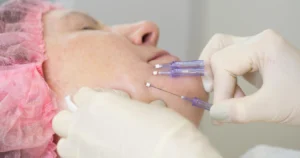

A skin tag is a small, fleshy expansion hanging off the skin’s surface and may have a stalk, also known as a peduncle. These skin tags are most likely to occur in areas of the body where the skin is pressed against other skin or clothing, but they can appear anywhere on the body.
Cutaneous papilloma, acrochordon, cutaneous tag, fibroma molluscum, soft fibroma, fibroma pendulum, fibroepithelial polyp, and Templeton skin tags are some of the other names for skin tags.
Tags on the skin are prevalent and tend to appear after the middle years of life. They have the same effect on both men and women. While they don’t cause health problems, they are nevertheless an unwanted skin condition. That’s why many want these skin tags removed.
To know more concerning skin tags and how they are removed, continue reading the article:
Skin tags, also known as skin tumors, are considered noncancerous and harmless. They are made up of a covering, also known as the epidermis, a core that is made up of fibers and ducts, nerve cells, and fat cells. They typically appear on the eyelids, neck, under the breasts, upper chest, armpits, and the groin area.
They typically go unnoticed unless they are located in a conspicuous place or are recurrently rubbed or scratched by something, such as jewelry, clothing, or shaving. In these cases, they are more likely to attract attention. Some people may have skin tags but are entirely unaware of them. In some instances, they can be removed painlessly by rubbing them off or falling off. However, it’s common for substantial skin tags may erupt under pressure.
Tags on the skin can have a smooth or bumpy surface depending on the person. It is common for them to be elevated from the skin’s surface on fleshy peduncles, also known as stalks. In most cases, they have a fleshy or slightly brownish coloration.
Most skin tags start off small, squashed like a pinhead bump. Some remain relatively small, while others continue to expand. They can have a diameter of anywhere between 1-2mm, but some can reach up to 5 cm in size.
Since a thin stalk attaches them to the skin, skin tags have a distinctive appearance compared to warts and other benign skin lesions. Skin tags are raised above the skin’s surface, whereas warts are typically flat.
Since skin tags are typically harmless, their removal is typically only done for reasons related to appearance or cosmetics. However, they can irritate, and extensive skin tags, particularly in areas where they may scrape against anything, such as clothing, jewelry, or skin, may need to be removed.
If you have a hefty skin tag on your face or under your arms, having it removed can make shaving much simpler.
Tags on the skin have the potential to fall off on their own over time. Talk to an aesthetic provider if you decide to have a skin tag removed—for example because it is upsetting you or you don’t like the way it looks—and they will be able to assist you with that problem.
Here are some possible cosmetic skin tag removal solutions for your skin tag problem:
Here are some surgical options that you can use to remove your skin tag problem:
Only a dermatologist, a specialist skin physician, a trained aesthetician, or another medical professional with training equivalent to that of a dermatologist should perform these procedures. Ophthalmologists specializing in eye care are the medical professionals most qualified to remove skin tags from the eyelid, particularly those located close to the lid margin.
Getting rid of a skin tag in the comfort of your home is generally not recommended due to the risk of bleeding and the possibility of infection.
However, very tiny tags can be eliminated by strapping dental floss or thin cotton thread around the foundation of the tag to cut off circulation to the tag. This method is effective for removing tiny tags.
Options available “over the counter” (OTC) can be purchased at pharmacies. These will freeze the skin tag, and after seven to ten days, it will fall off on its own. You can also buy these over the internet, but it is strongly advised that you consult a qualified medical professional before using any of these treatments.
These medications are very comparable to those that are used to remove warts.
Perhaps someone told you before that trying to remove skin tags will cause more of them to increase. However, there is no evidence to reinforce the claim that removing skin tags will cause additional skin tags to develop; this assertion is merely a myth.
There is a lot of mystery surrounding the origin of skin tags, but one theory suggests that they are caused when clusters of collagen and blood vessels get trapped inside thicker pieces of skin.
Likewise, since they are more prevalent in skin creases or folds, skin rubbing against the skin may be the primary cause. But it appears that some individuals can inherit an increased propensity to develop skin tags.
Skin tags can occur in both males and females, but they are more common in pregnant women, obese people, and diabetics. Skin tags also tend to appear more frequently during pregnancy.
In rare cases, they have been linked to hyperinsulinemia, a condition in which an abnormally high level of insulin is circulating in the blood.
Although they do not ordinarily result in any discomfort, they are incredibly annoying, and you would likely like to get rid of them. During the removal process at Bloom MedSpa, we either use clipping or cryotherapy depending on the location, size, and characteristics of the unwanted skin tag. If interested, don’t hesitate to contact us and reach out to our services anytime!